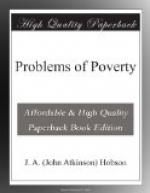There are several reasons why the growth of effective organization among women-workers must be slow. In the first place, as we have seen, a large proportion of their work is “out work” done at home or in small domestic workshops. Now labour organizations are necessarily strong and effective, in proportion as the labourers are thrown together constantly both in their work and in their leisure, have free and frequent opportunities of meeting and discussion, of educating a sense of comradeship and mutual confidence, which shall form a moral basis of unity for common industrial action. But to the majority of women-workers no such opportunities are open. Even the factory workers are for the most part employed in small groups, and are dispersed in their homes. Combination among the mass of home-workers or workers in small sweating establishments is almost impossible. The women’s Unions have hitherto been successful in proportion as the trades are factory trades. Where endeavours have been made to organize East End shirt-makers, milliners, and others who work at home, very little has been achieved. In those trades where it is possible to give out an indefinite amount of the work to sub-contractors, or to workers to do at home, it seems impossible that any great results can be thus attained. Even in trades where part of the work is done in factories, the existence of reckless competition among unorganized out-workers can be utilized by unprincipled employers to destroy attempts at effective combination among their factory hands. The force of public opinion which may support an organization of factory workers by preventing outsiders from underselling, can have no effect upon the competition of home-workers, who bid in ignorance of their competitors, and bid often for the means of keeping life in themselves and their children. The very poverty of the mass of women-workers, the low industrial conditions, which Unionism seeks to relieve, form cruel barriers to the success of their attempts. The low physical condition, the chronic exhaustion produced by the long hours and fetid atmosphere




